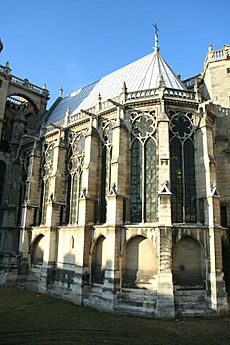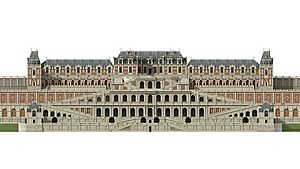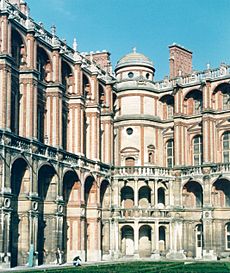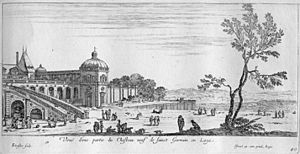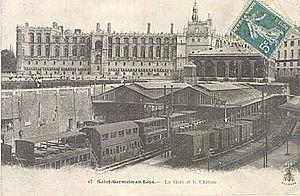Château de Saint-Germain-en-Laye facts for kids
Quick facts for kids Château de Saint-Germain-en-Laye |
|
|---|---|
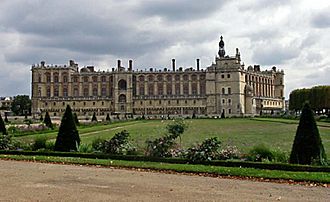 |
|
| General information | |
| Location | Saint-Germain-en-Laye, France |
| Construction started | 1124 |
| Design and construction | |
| Architect | Pierre Chambiges |
The Château de Saint-Germain-en-Laye is an old royal palace located in Saint-Germain-en-Laye, a town about 19 kilometers (12 miles) west of Paris, France. Today, this amazing castle is home to the National Museum of Archaeology, where you can explore ancient artifacts from France's past.
Contents
History of the Royal Palace
Early Beginnings: 12th and 13th Centuries
The very first castle on this spot was built in 1124 by King Louis VI. It was called the Grand Châtelet. Later, in the 1230s, King Louis IX made the castle much bigger.
King Louis IX also built a special chapel at the castle. This chapel was designed to hold important religious items, like a piece of the Crown of Thorns. It was built by his favorite architect, Pierre de Montreuil. This chapel was a bit like a smaller version of the famous Sainte-Chapelle that King Louis IX built in Paris a few years later. Both chapels had many tall, narrow windows, making the inside feel very open and bright.
In 1346, during a war, the castle was burned by Edward the Black Prince. Only the Gothic chapel survived from that time. The main castle, known as the Château Vieux (Old Castle), was rebuilt by King Charles V in the 1360s.
Royal Expansions: 16th to 18th Centuries
The oldest parts of the castle you see today were rebuilt by King Francis I starting in 1539. Over time, it was expanded even more. In 1548, special rooms were prepared for Mary, Queen of Scots and the children of King Henry II of France.
King Henry II later built a completely new castle nearby, called the Château-Neuf de Saint-Germain-en-Laye (New Castle). This new castle had amazing gardens with three huge terraces that went down a slope towards the Seine River. These gardens were designed in the Italian style, which was new and exciting in France at the time. They helped inspire the famous French formal garden style that became popular later.
The gardens were laid out in 1595 for King Henry IV by Claude Mollet, a famous gardener. These gardens were very important because they showed how new garden styles from Italy were coming to France.
Louis XIV and the Palace
King Louis XIV was born at the Château Neuf in 1638. He loved the old castle, the Château Vieux, more than the new one. In the 1660s, the Château Neuf was left empty and later taken down.
From 1663 to 1682, Louis XIV and his team of famous architects and gardeners, including Louis Le Vau, Jules Hardouin-Mansart, and André Le Nôtre, worked to make the old castle even grander. André Le Nôtre also redesigned the gardens from 1669 to 1673. He created a long stone terrace, about 2.4 kilometers (1.5 miles) long, which offers a stunning view over the Seine valley and Paris in the distance.
In 1688, King Louis XIV gave the château to King James II of England after James had to leave Britain. King James lived in the château for 13 years. His daughter, Louise-Marie Stuart, was born there in 1692. King James is buried in a nearby church. Many of his supporters, called Jacobites, stayed at the château until the French Revolution in 1793.
Modern Times: 19th to 21st Centuries
In the 19th century, Napoleon I used the château as a training school for his cavalry officers. Later, Napoleon III started a big project to restore the castle in 1862. He wanted to bring back its original French Renaissance style.
In 1867, the château became the Musée des Antiquités Nationales (National Museum of Antiquities). This museum showed off ancient objects found in France. Today, it is known as the Musée d'Archéologie Nationale (National Museum of Archaeology). Its collections include amazing finds from the Stone Age all the way up to the early Middle Ages.
On September 10, 1919, an important agreement called the Treaty of Saint-Germain-en-Laye was signed at the château. This treaty officially ended the war between the Allies of World War I and Austria after World War I.
During World War II, from 1940 to 1944, the château was used as the headquarters for the German Army in France.
Gallery


